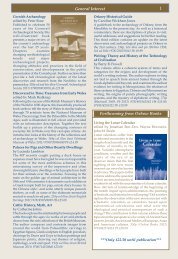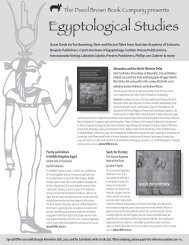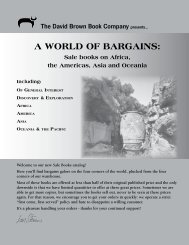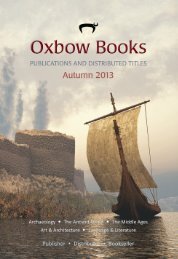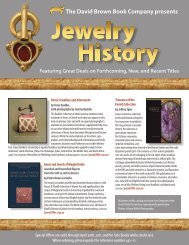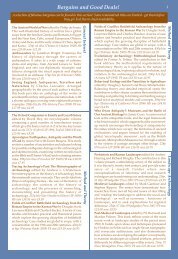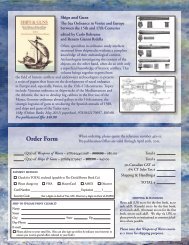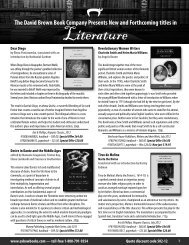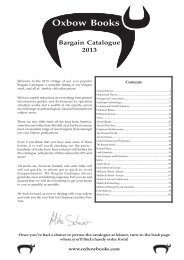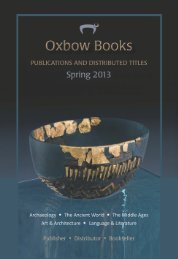New Distributed Titles Fall 2009 - Oxbow Books
New Distributed Titles Fall 2009 - Oxbow Books
New Distributed Titles Fall 2009 - Oxbow Books
You also want an ePaper? Increase the reach of your titles
YUMPU automatically turns print PDFs into web optimized ePapers that Google loves.
Die Casa del Fauno in Pompeji (VI 12) 1<br />
Bauhistorische Analyse<br />
Die stratigraphische Befunde und Funde der<br />
Ausgrabungen in den Jahren 1961 bis 1963<br />
by Andrea Faber and Adolf Hoffmann<br />
The Casa del Fauno is among the largest and most well-furnished<br />
Pompeian houses buried by the eruption of Mount Vesuvius in 79<br />
AD. This volume - Part I of a two-part study (Part II forthcoming) -<br />
presents the results of excavations undertaken within and under the<br />
floors of the house, presenting a thorough architectural history of<br />
the building. Additionally, a large number of stratified finds allows<br />
for the reconstruction of Pompeii’s settlement history as far back as the late 6th century BC. German text.<br />
396p, 114 b/w & 19 col illus, hardback, 9783895006500, $168.00(s), Reichert Verlag, September <strong>2009</strong>,<br />
Archäologische Forschungen 25.<br />
Hellenistic and Roman Butrint<br />
by Inge Lyse Hansen<br />
The Hellenistic city of Butrint, with its flourishing sanctuary of Asclepius, was transformed<br />
when it was made a Roman colony, first by Caesar then Augustus. Being<br />
able to deploy its heroic ancestry linked to Aeneas and Troy, the city articulated its<br />
special relationship with the imperial family in fine portrait dedications and drew<br />
inspiration from Augustus’ own city of Nicopolis. Drawing on the latest archaeological<br />
research from Butrint, this richly illustrated book presents a new understanding<br />
of the making and development of the ancient Epirote city and discusses the impact<br />
of patronage bestowed on it by the emperor and elite families in Rome.<br />
96p, c.100 col illus, paperback, 9780953555680, $24.00, The Butrint Foundation,<br />
September <strong>2009</strong>.<br />
Bürgerrechtsentzug oder Fremdenausweisung?<br />
Studien zu den Rechten von Latinern und weiteren Fremden<br />
sowie zum Bürgerrechtswechsel in der Römischen Republik<br />
(5. bis frühes 1. Jh. v.Chr.)<br />
by Altay Coşkun<br />
This volume focuses on Livy’s reports of the<br />
expulsion of Latins and Italians from Rome<br />
in the years 206–173 BC. While previous<br />
research has identified the expelled as<br />
disenfranchised Roman citizens, this study<br />
shows that only migrants without Roman<br />
citizenship were expelled. The author puts<br />
his findings into their legal historical contexts.<br />
German text.<br />
236p, paperback, 9783515093033, $80.00(s),<br />
Franz Steiner Verlag, June <strong>2009</strong>, Hermes – Einzelschriften 101.<br />
rome � ancient italy<br />
Edizioni Polistampa – <strong>New</strong>ly distributed by DBBC!<br />
Pitigliano, Sovana, Sorano, Saturnia<br />
and their Tuff-Rock Cultures<br />
by Emanuela Morelli, photographs by Roberto Germogli<br />
The southern part of Tuscany in the Maremma uplands between the ancient volcano<br />
Mount Amiata, the meanderings of the Fiora river and its tributary, and the<br />
border with the Lazio Region are commonly known as Toscana dei tufi, Tuscany of<br />
the Tuff-rock, because tuff-rock is the first characteristic of this fascinating landscape<br />
of priceless archaeological heritage. Here, man has made skilful use of the<br />
particular nature of the surroundings, creating unique, sometimes magical settings<br />
which surround the visitor and play on his every sense. Geologically, the area is<br />
marked by tuff-rock shelves that stretch from Pitigliano and Sorano to as far as<br />
Lazio and Umbria.<br />
132p, col illus, paperback, 9788859604297, $16.50(s), Edizioni Polistampa,<br />
December 2008.<br />
Alle origini di Livorno<br />
L’età etrusca e romana<br />
edited by Stefano Bruni<br />
This catalogue from an exhibition held in Livorno in 2008 reconstructs the evolution<br />
of settlements in the area between the Etruscan and Imperial Roman periods.<br />
Numerous photographs of diverse objects drawn from earlier and more recent archeological<br />
discoveries document the history of Livorno and surrounding regions<br />
between the thirteenth century BC and the seventh century AD. Italian text.<br />
304p, b/w & col illus, paperback, 9788859605546, $48.00(s), Edizioni Polistampa,<br />
October <strong>2009</strong>.<br />
www.dbbconline.com 29




